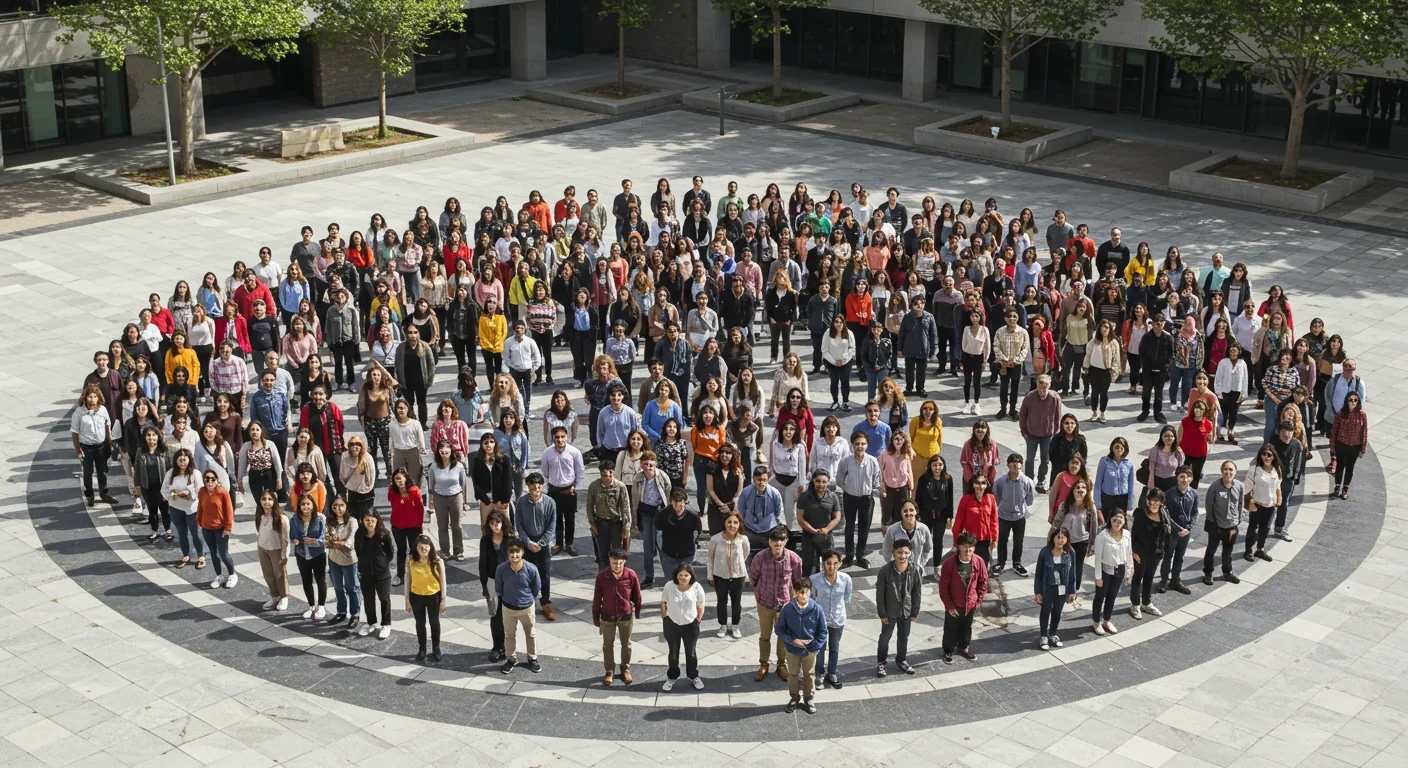Why Your Brain Sees Gods and Ghosts in Random Events

TL;DR: Your brain has a biological limit of 150 meaningful relationships. Understanding the Dunbar number helps you optimize personal networks, build better teams, and navigate social media's illusion of unlimited connection.

By 2035, your teenager might have 5,000 TikTok followers, but neuroscience suggests they'll still only truly know 150 of them. That's not a failure of social media—it's biology.
Somewhere in the vast neural networks of our brains, there's a hard limit on how many people we can genuinely care about. Robin Dunbar, an evolutionary psychologist at Oxford, discovered this by studying primates and their neocortex ratios. His finding? Humans max out at around 150 stable relationships. Not connections. Not followers. Relationships where you know someone's story, remember their last conversation, and would help them move furniture on a Saturday.
This isn't just academic trivia. The Dunbar number shapes everything from how ancient villages organized themselves to why your company's org chart breaks down after certain team sizes. Understanding it could transform how you build your career network, design organizations, or navigate the chaos of digital social life.
Dunbar didn't wake up one morning and decide 150 was a nice round number. He was studying social bonding in primates, where grooming serves as the social glue. Chimps spend hours picking bugs off each other—not just for hygiene, but to maintain alliances and friendships.
But there's a problem: grooming takes time. Lots of it. For primates, this physical constraint caps group sizes at around 50 individuals. Beyond that, there simply aren't enough hours to maintain bonds with everyone.
Early humans faced a similar bottleneck until we evolved a workaround: language. Instead of one-on-one grooming sessions, humans could bond in groups through conversation and, importantly, laughter. These mechanisms released the same bonding neurochemicals—endorphins—but scaled to multiple people simultaneously. Think of language as "distant grooming" that let us expand our social circles without spending all day picking nits.
Dunbar correlated primate brain sizes with their social group numbers and found a consistent pattern: the larger the neocortex relative to brain size, the bigger the social group. When he applied this formula to human brain anatomy, the prediction landed squarely at 150.
The 150 figure isn't arbitrary guesswork. It's rooted in comparative neurobiology. Dunbar examined the relationship between neocortex volume and social group size across primate species. The neocortex is the brain's outer layer responsible for higher-order thinking, including social cognition—recognizing faces, tracking relationships, understanding others' intentions.
As brains evolved larger neocortices, primates could manage more complex social webs. When Dunbar extrapolated the curve to humans, whose neocortex ratio is the highest among primates, the math pointed to 150 as our cognitive ceiling for stable relationships.
Real-world data backs this up. Historical records show that Neolithic farming villages commonly clustered around 150 inhabitants. Roman military units, medieval English villages, even modern Hutterite communities—they all gravitate toward this threshold. When groups exceed 150, they tend to fragment or require more formal hierarchies and rules to maintain cohesion.
Why? Because tracking social relationships demands mental effort. You need to remember who's allied with whom, who owes you a favor, whose birthday is coming up, and who's feuding with whom. At some point, your brain runs out of RAM.

The Dunbar number doesn't mean you relate to all 150 people equally. Instead, our social lives are structured in concentric circles of decreasing intimacy, like rings around a bullseye.
The innermost circle: 5 people. These are your closest confidants—partners, best friends, immediate family. You'd trust them with your darkest secrets and call them in a crisis at 3 a.m.
Next layer: 15 people. Your good friends. You see them regularly, share meaningful experiences, and genuinely care about their well-being.
The 50 layer. These are friends and close colleagues. You maintain active relationships through regular contact—dinner parties, work projects, group chats.
The 150 layer. Meaningful connections you could call on for a favor or have a substantive conversation with. You know their context and history.
Beyond 150, people become acquaintances or familiar strangers. You might recognize their face or know their name, but the relationship lacks depth.
Research suggests it takes about 50 hours to move from acquaintance to casual friend, 90 hours to reach friendship, and more than 200 hours to build a best-friend bond. Time is the limiting resource, and there's only so much of it to go around.
So what happens when you try to cram more than 150 people into a cohesive group? Things get messy.
First, relationships lose depth and stability. You might know someone's name and job title, but you don't remember their personality quirks or personal struggles. Connections become transactional rather than relational.
Second, communication overhead explodes. In a group of 16 people, there are 120 possible one-on-one relationships. Scale that to 50, and you're managing 1,225 potential connections. At 100 members, it's 4,950 relationships. The complexity becomes unmanageable without formal systems—org charts, mailing lists, project management software.
Third, trust erodes. Studies in organizational behavior show that when teams grow too large, members report lower job satisfaction and higher burnout. Why? Because maintaining trust requires ongoing interaction and mutual understanding, which becomes impossible when the group exceeds cognitive limits.
Interestingly, this isn't just a modern problem. The biblical story of Moses delegating judicial authority—advised by his father-in-law Jethro to organize the Israelites into manageable units—reflects an intuitive grasp of these same constraints thousands of years ago. Ancient leaders understood what neuroscience would later confirm: humans need structures that respect cognitive capacity.
Enter social media, where the entire premise seems designed to violate Dunbar's limits. Facebook initially capped friend counts, but users routinely maintain networks of 300, 400, even thousands of connections. Instagram influencers have millions of followers. Does this mean technology has liberated us from our cognitive constraints?
Not quite. Research on college students' Facebook networks reveals something telling: while friend counts inflate, most of these additions are weak ties—acquaintances and activity connections, not close relationships. The median user might have 300 Facebook friends, but their actual interactions concentrate on a much smaller core group.
In fact, online networks don't escape Dunbar's limit so much as redistribute it. You might follow 1,000 people on Twitter, but you only genuinely engage with a fraction. The rest are ambient awareness—background noise rather than relationships.
More troubling, large online networks can distort social dynamics. When interactions exceed our cognitive capacity, we shift toward more generalized moral judgments. Instead of seeing individuals with nuanced contexts, we categorize people into "good" or "evil" camps. This fuels polarization and outrage.
Consider this: a meta-analysis of nearly 5 million social media posts found that each moral-emotional word in a post increases retweets by 12%. Platforms amplify moral outrage because it drives engagement. But this creates feedback loops that intensify conflict rather than understanding.

Before we dismiss all those extra connections as meaningless clutter, it's worth recognizing that weak ties serve a different purpose. They're not substitutes for close relationships but rather bridges to new information and opportunities.
Your best friend probably knows the same things you do. But that acquaintance from a conference three years ago? They operate in different circles and have access to different knowledge. Weak ties are how job opportunities spread, how ideas cross disciplines, and how social movements gain traction.
The problem isn't having weak ties—it's confusing them with strong ones. Social media platforms often blur this distinction, creating an illusion of intimacy where none exists. You see someone's vacation photos and assume you're close, but online ties provide less social support than offline relationships.
For organizations, respecting the Dunbar number isn't just theoretical—it's practical. Companies that structure teams around these cognitive limits report better collaboration and morale.
Gore-Tex, the materials science company, famously limits manufacturing plants to around 150 employees. When a facility grows beyond that, they build a new plant rather than expand the existing one. Their reasoning? Once you exceed 150, you lose the sense of mutual accountability and need bureaucratic controls to compensate.
Similarly, the Swedish Tax Agency restructured into offices capped at 150 employees, which improved both efficiency and employee satisfaction. Small, autonomous units foster trust, reduce communication overhead, and enable faster decision-making.
Military organizations have known this for centuries. Roman legions, modern infantry companies, and special forces units all cluster around the 150-person mark. It's the sweet spot where everyone knows everyone else well enough to trust them under pressure.
Knowing the Dunbar limit, how should you manage your own networks?
Focus on depth, not breadth. It's tempting to collect contacts like Pokémon cards, but quality trumps quantity. Your innermost circles—the 5 and the 15—deserve the majority of your relational energy. Invest time in these people. Call them. Have meals with them. Show up when they need help.
Audit your 150 periodically. Relationships drift. People move, change careers, or simply grow apart. Every year or so, consciously assess who's in your meaningful network. Are there people you're neglecting who should be closer? Are you wasting energy on relationships that no longer serve you?
Use systems beyond 150. If your professional life requires managing more than 150 contacts—and for many people it does—build external systems to compensate. CRM tools, contact notes, regular calendar reminders. Your brain can't track 300 people, but your phone can.
Differentiate platforms by purpose. LinkedIn is for weak ties and professional visibility. Instagram for shared interests. Close messaging apps for your inner circles. Don't expect one platform to serve all relationship types equally.
Prune ruthlessly. Social media encourages hoarding connections, but this creates clutter. Unfollow people who don't add value. Decline LinkedIn requests from strangers. Your attention is finite; guard it.
Which brings us to the big question: are we stuck at 150 forever, or might technology eventually expand our cognitive capacity?
Some researchers speculate that AI-powered relationship managers could augment our social cognition. Imagine an assistant that reminds you of key details about people before meetings, suggests who to reconnect with, or flags important life events. Could this extend our effective Dunbar number?
Maybe. But there's a catch: even if tools help us remember more people, they can't manufacture genuine emotional connection or create more hours in the day. Relationships require time and presence, neither of which scales easily.
Another possibility is that virtual reality and immersive technologies could make remote interactions feel more like in-person contact, strengthening bonds that would otherwise remain weak. Early research on VR social spaces suggests that shared experiences in virtual environments can create surprisingly deep connections.
But evolution moves slowly. Our brains are essentially the same hardware that powered Neolithic villages. Cultural and technological changes happen orders of magnitude faster than biological ones. For the foreseeable future, 150 remains our ceiling.
The Dunbar number isn't a constraint to fight against—it's a reality to embrace. Understanding it lets you make smarter choices about where to invest your social energy.
In a world obsessed with growth metrics and follower counts, recognizing that quality matters more than quantity is quietly radical. You don't need thousands of connections. You need a few dozen people who genuinely know you and whom you genuinely know.
This matters more than ever as we navigate increasingly digital lives. The platforms will keep pushing you to expand your networks, to engage with more content, to chase viral reach. But your brain hasn't changed. It still maxes out at 150.
So build your inner circles with intention. Show up for the people who matter. Let the weak ties remain weak. And remember that the most valuable networks aren't the biggest ones—they're the ones where every connection means something.
Because at the end of the day, we're still primates. We've traded grooming for group chats and villages for office buildings, but the fundamental wiring remains. We're built for tribes of 150, not stadiums of thousands.
And honestly? That's not a bug. It's a feature.

Recent breakthroughs in fusion technology—including 351,000-gauss magnetic fields, AI-driven plasma diagnostics, and net energy gain at the National Ignition Facility—are transforming fusion propulsion from science fiction to engineering frontier. Scientists now have a realistic pathway to accelerate spacecraft to 10% of light speed, enabling a 43-year journey to Alpha Centauri. While challenges remain in miniaturization, neutron management, and sustained operation, the physics barriers have ...

Epigenetic clocks measure DNA methylation patterns to calculate biological age, which predicts disease risk up to 30 years before symptoms appear. Landmark studies show that accelerated epigenetic aging forecasts cardiovascular disease, diabetes, and neurodegeneration with remarkable accuracy. Lifestyle interventions—Mediterranean diet, structured exercise, quality sleep, stress management—can measurably reverse biological aging, reducing epigenetic age by 1-2 years within months. Commercial ...

Data centers consumed 415 terawatt-hours of electricity in 2024 and will nearly double that by 2030, driven by AI's insatiable energy appetite. Despite tech giants' renewable pledges, actual emissions are up to 662% higher than reported due to accounting loopholes. A digital pollution tax—similar to Europe's carbon border tariff—could finally force the industry to invest in efficiency technologies like liquid cooling, waste heat recovery, and time-matched renewable power, transforming volunta...

Humans are hardwired to see invisible agents—gods, ghosts, conspiracies—thanks to the Hyperactive Agency Detection Device (HADD), an evolutionary survival mechanism that favored false alarms over fatal misses. This cognitive bias, rooted in brain regions like the temporoparietal junction and medial prefrontal cortex, generates religious beliefs, animistic worldviews, and conspiracy theories across all cultures. Understanding HADD doesn't eliminate belief, but it helps us recognize when our pa...

The bombardier beetle has perfected a chemical defense system that human engineers are still trying to replicate: a two-chamber micro-combustion engine that mixes hydroquinone and hydrogen peroxide to create explosive 100°C sprays at up to 500 pulses per second, aimed with 270-degree precision. This tiny insect's biochemical marvel is inspiring revolutionary technologies in aerospace propulsion, pharmaceutical delivery, and fire suppression. By 2030, beetle-inspired systems could position sat...

The U.S. faces a catastrophic care worker shortage driven by poverty-level wages, overwhelming burnout, and systemic undervaluation. With 99% of nursing homes hiring and 9.7 million openings projected by 2034, the crisis threatens patient safety, family stability, and economic productivity. Evidence-based solutions—wage reforms, streamlined training, technology integration, and policy enforcement—exist and work, but require sustained political will and cultural recognition that caregiving is ...

Every major AI model was trained on copyrighted text scraped without permission, triggering billion-dollar lawsuits and forcing a reckoning between innovation and creator rights. The future depends on finding balance between transformative AI development and fair compensation for the people whose work fuels it.